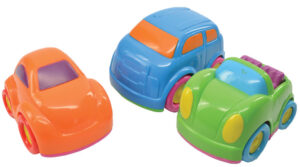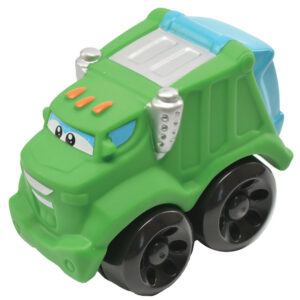Social interaction skills
Toddlers participate in open-ended play with toy vehicles, with guided opportunities to pay attention to actions of peers.



[Invite several toddlers to join you on the floor with a collection of toy vehicles.]
 Here are different toy cars to play with. Which cars would you like to play with?
Here are different toy cars to play with. Which cars would you like to play with?
[Invite each toddler to pick two vehicles to play with. If you anticipate conflict over particular cars, you may wish to offer pairs of similar cars for the toddlers to choose from.]
 [Point to and describe the toy vehicles each toddler has chosen. Example: “Gabriela picked a truck and a car. Andrew has a car and a truck. Tanya has a dump truck and a police car.”
[Point to and describe the toy vehicles each toddler has chosen. Example: “Gabriela picked a truck and a car. Andrew has a car and a truck. Tanya has a dump truck and a police car.”
Invite the toddlers to play with their toy vehicles in their own way. Emphasize using the vehicles safely. Example: “Cars are for driving, like this. We are not safe when a car is up in the air. We are going to drive our cars safely.”
Use strategies, such as the following, to support toddlers’ play and awareness of what others are doing:
[Describe the time together, focusing on interactions. Example: “We had fun playing with the cars! We watched what friends did with their cars. Andrew showed us how his car can move fast. Gabriela had fun putting our pig in the truck.”]
Look for opportunities to draw toddlers’ attention to the actions of others. Awareness of others is an important part of positively interacting with others. Offering a range of toy vehicles can help toddlers share and play together. Also look for opportunities to demonstrate or describe ways toddlers can manage conflicts in sharing toys or space. Young toddlers cannot be expected to necessarily know how to share toys or negotiate problems, such as being crowded by another toddler’s actions. Watch for appropriate chances to give specific suggestions on how a toddler can manage a situation. Remember that your approach provides a model for toddlers to follow.
Extra support
Enrichment
Social interaction skills
Toddlers participate in play with toy vehicles on a pretend road, with guided opportunities to imitate the actions of a peer(s).



Be Prepared: Tape the paper to a hard floor and draw two simple roads across the paper.
Invite several toddlers to join you to drive toy vehicles on a pretend road. Give each toddler a vehicle and encourage toddlers to feel and look at parts of their vehicle, especially the wheels. Demonstrate driving a car or truck on the paper road and invite toddlers to do the same. Encourage toddlers to watch what others do with their vehicle on the pretend road. If a toddler seems interested in what another toddler is doing, ask the toddler if he/she would like to do the same thing. Examples: “Jeremiah is driving his truck back and forth. Would you like to drive a truck back and forth?” “You are watching Alexis follow the lines of the road with her pretend car. Would you like to follow the lines with your car?”
Describe positive social interactions that you observe. Example: “Jeremiah and Hailey are driving their cars side by side. I think they are driving to the same place! They are playing together.” Also, recognize and extend toddlers’ comments without directing the play.
Playing with vehicles in close proximity to others facilitates toddlers’ awareness of the actions of others. Toddlers will likely play side by side during this activity. Notice both verbal and nonverbal interactions. The pretend road provides a focus for the play and a structure for imitating another’s actions.
Describe toddlers’ actions and encourage others to watch and do the same if they would like. Imitation is a central part of young children’s play and social interactions. Many toddlers will see interesting uses of a toy that they would like to also do. Be careful to respect the interests of a toddler, however; some toddlers may want to watch but not do what another toddler is doing. Look for opportunities to draw attention to, but not prescribe, toddler-initiated play with the toys and pretend road.
There may be situations where you need to assume a more directive role in helping toddlers play alongside each other. Example: In the Extra Support example of suggesting a toddler (Jeremiah) tell another child (Alexis) that she’s getting too close to his play space, it may be appropriate to suggest an alternative for Alexis, such as drawing a new road for her car to drive on. This suggestion may prompt others to also want to draw their own road!
Extra support
Enrichment
Social interaction skills
Toddlers participate in play focused on helping toy vehicles roll down a “big hill,” with guided opportunities to imitate the actions of a peer(s).



Be Prepared: Set up a slight incline in the play area with sturdy cardboard or a plastic tray turned upside down. Secure the incline structure so it does not fall. Place toy cars on either side of the incline.
Invite several toddlers to play with cars and a “big hill.” Sit near the toddlers and encourage them to release their car at the top of the hill, one at a time. If toddlers appear unsure how to play with the hill, demonstrate how to let go of a car so it rolls down. Encourage toddlers to catch the cars as they reach the floor so the cars can be used to repeat the actions. Encourage toddlers to watch how their peers use a toy vehicle and to take turns rolling cars down the hill. Example: “Wow, your car went so fast down the hill, Jackson! Now it is Kailey’s turn to see how fast her car goes. Let’s watch Kailey’s car go down!” Toddlers also may wish to exchange vehicles with their peers.
This activity provides a more focused opportunity for toddlers to watch (and potentially imitate) the actions of others than Option 2. Toddlers are invited to engage in a similar action (help a car roll down a hill). Attention to some specifics of what a toddler does with his/her toy vehicle is necessary for imitation. This means your efforts to help toddlers notice another toddler’s actions need to be specific. Example: Does a toddler put his/her vehicle on the edge of the “hill” or at the peak of the “hill”? Toddlers will differ in their interest in a deeper level of attention to how others launch their vehicle on the hill. Also, some toddlers may take time to join, preferring to initially sit nearby and watch. Toddlers who want to watch only may enjoy sitting with you during the activity. (See Extra support tip below.)
Extra support
Enrichment
Materials Needed: assortment of toy cars and trucks, five-foot length of paper with simple roads drawn across, several small boxes to represent houses or garages
Leave the paper from Option 2 on the floor with a basket of vehicles for the toddlers to revisit. (See the Be Prepared section of Option 2.) Invite several toddlers at a time to play together with the materials. Encourage toddlers to notice the actions of their peers while they play.
Materials Needed: assortment of toy cars and trucks, flat surface to create an incline (see Option 3), assortment of blocks
Children of all ages will enjoy rolling vehicles down an incline (Option 3). Depending on the size of the group, you may wish to set up two “big hills.” Children may enjoy building block structures close to the hill, and maybe a barricade to stop the cars at the bottom. Toddlers will enjoy watching older children use the materials and may attempt to imitate their actions. Babies may enjoy playing with soft blocks and age-appropriate cars during the activity.